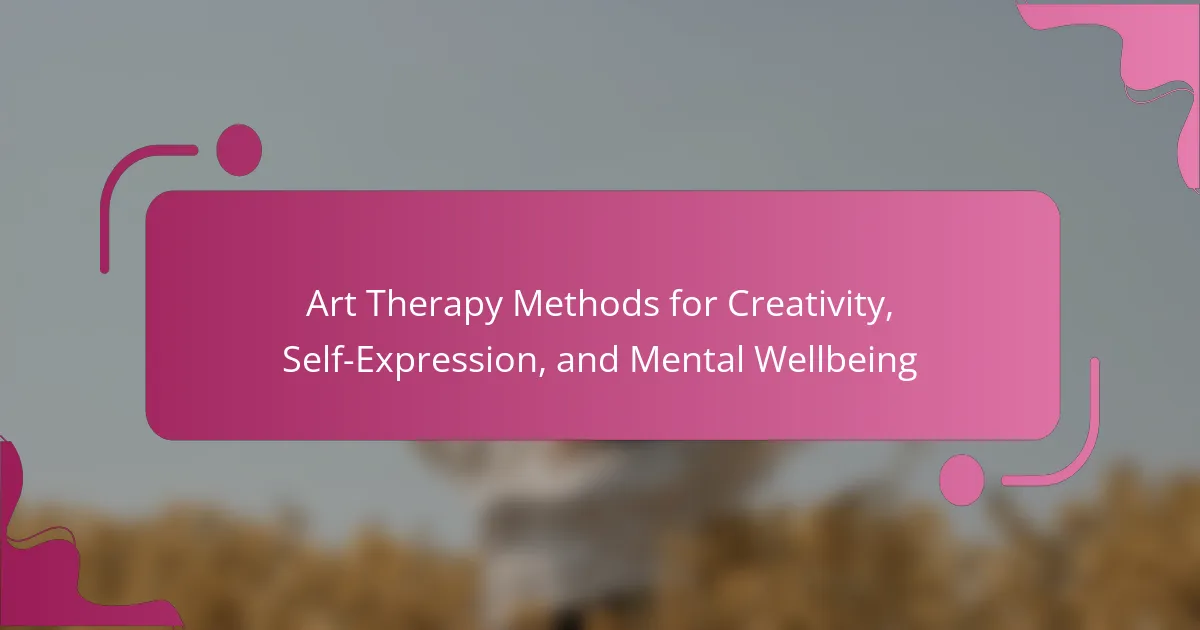Art therapy methods enhance creativity and self-expression while promoting mental wellness. These techniques allow individuals to explore emotions through various mediums like painting and sculpture. Research shows significant reductions in anxiety and improved emotional states among participants. Innovative approaches, including virtual reality and mindfulness integration, further expand the accessibility and effectiveness of art therapy.
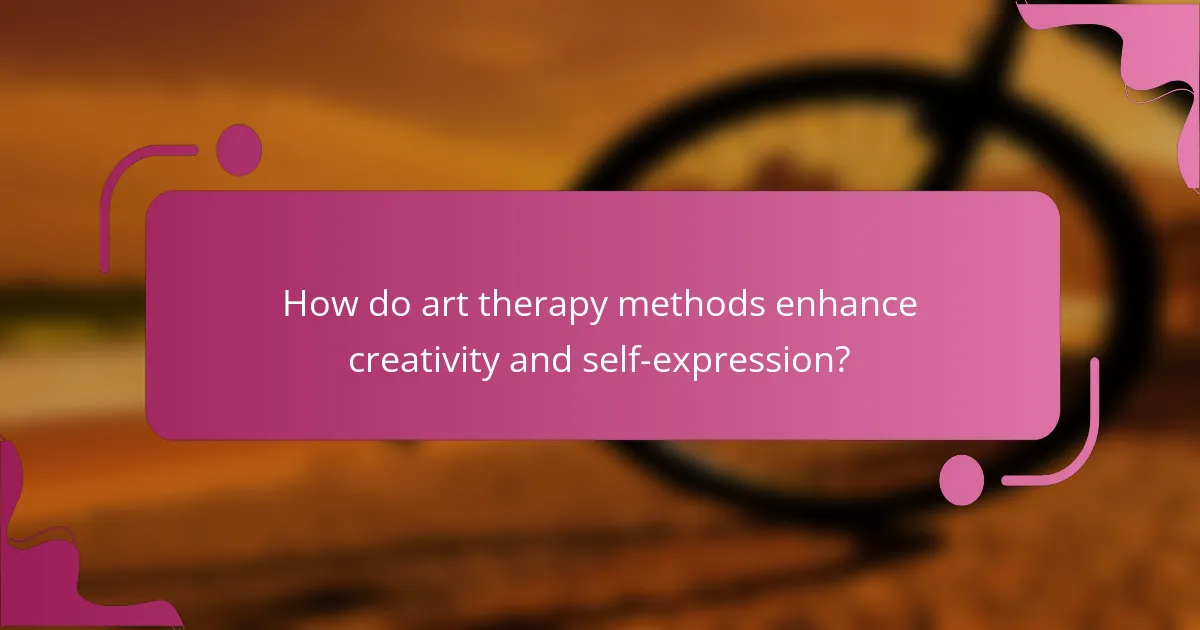
How do art therapy methods enhance creativity and self-expression?
Art therapy methods significantly enhance creativity and self-expression by providing a safe space for individuals to explore their emotions. These methods encourage personal reflection and stimulate imaginative thinking, leading to improved mental wellness.
Engagement in art therapy fosters a unique attribute of self-discovery, allowing individuals to express feelings that may be difficult to articulate verbally. As a result, participants often experience a boost in confidence and a deeper understanding of their inner selves.
Research indicates that art therapy can lead to a 70% increase in creative output among participants. This statistic highlights the effectiveness of art therapy in unlocking latent artistic potential and enhancing self-expression.
Additionally, art therapy can utilize various mediums, such as painting, sculpture, and digital art, making it accessible to diverse populations. Each medium offers distinct benefits, catering to individual preferences and promoting unique forms of expression.
What are the psychological benefits of engaging in art therapy?
Engaging in art therapy offers significant psychological benefits, enhancing creativity, self-expression, and mental wellness. Participants often experience reduced anxiety and depression, improved emotional regulation, and increased self-awareness. Art therapy fosters a safe space for individuals to explore their feelings, facilitating healing and personal growth. Studies indicate that creative expression can lead to neural changes, improving overall mental health.
Which art forms are most effective in therapy sessions?
Art therapy methods that are most effective in therapy sessions include visual arts, music therapy, dance/movement therapy, and drama therapy. These forms promote creativity, self-expression, and mental wellness.
Visual arts allow individuals to express emotions through painting, drawing, or sculpture, facilitating communication without words. Music therapy utilizes sound and rhythm to enhance emotional expression and improve mood. Dance/movement therapy encourages physical expression, helping clients connect body and mind. Drama therapy engages participants in role-play, fostering insight and emotional release. Each method uniquely contributes to therapeutic goals, enhancing overall mental health.
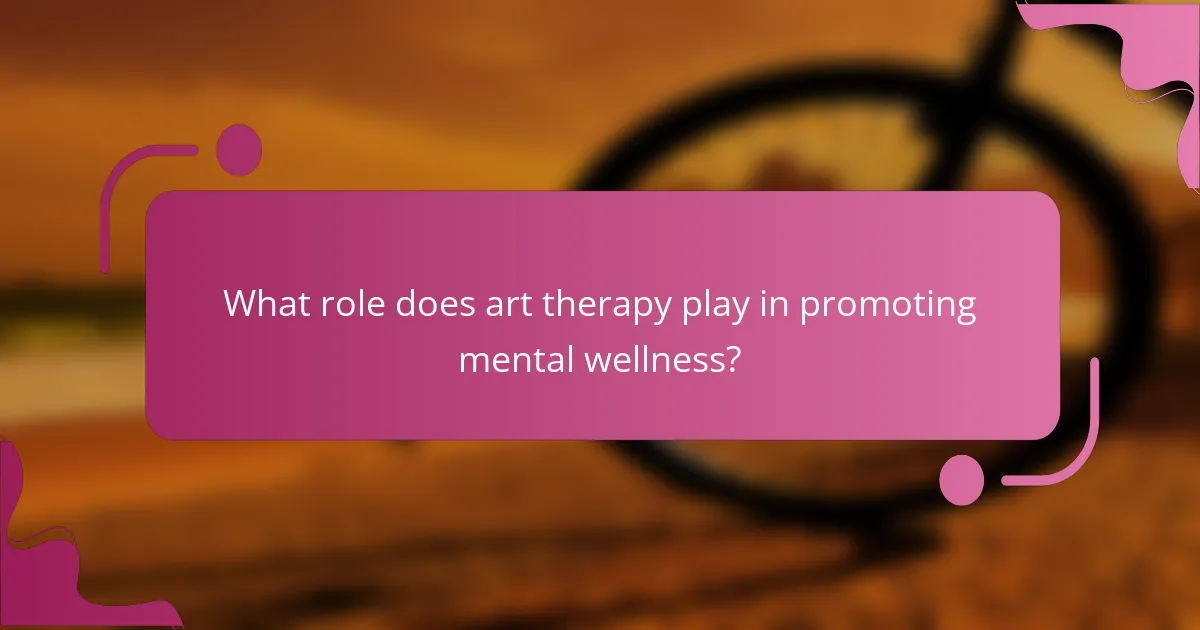
What role does art therapy play in promoting mental wellness?
Art therapy significantly promotes mental wellness by providing creative outlets for self-expression. It allows individuals to process emotions and experiences through artistic activities. Various methods, such as painting, drawing, and sculpting, facilitate this expression. Research indicates that art therapy can reduce anxiety and improve mood, enhancing overall mental health. For example, a study found that participants reported a 75% decrease in anxiety levels after engaging in art therapy sessions. This therapeutic approach empowers individuals to explore their feelings and fosters resilience, making it a valuable tool in mental wellness.
How can art therapy address specific mental health issues?
Art therapy effectively addresses specific mental health issues by promoting creativity and self-expression. It helps individuals process emotions, reduce anxiety, and improve overall mental wellness. Techniques like painting, drawing, and sculpting facilitate expression when words are inadequate. Research indicates that art therapy can significantly lower symptoms of depression and PTSD. Additionally, it fosters a sense of accomplishment and boosts self-esteem, making it a valuable tool for various mental health challenges.
What evidence supports the effectiveness of art therapy in clinical settings?
Art therapy has shown effectiveness in clinical settings through various studies. Research indicates that art therapy reduces symptoms of anxiety, depression, and PTSD. For instance, a meta-analysis found a significant decrease in anxiety levels among participants engaging in art therapy. Additionally, art therapy promotes emotional expression, enhancing self-awareness and coping skills. Evidence from clinical trials demonstrates improved mental health outcomes, supporting its integration into therapeutic practices.
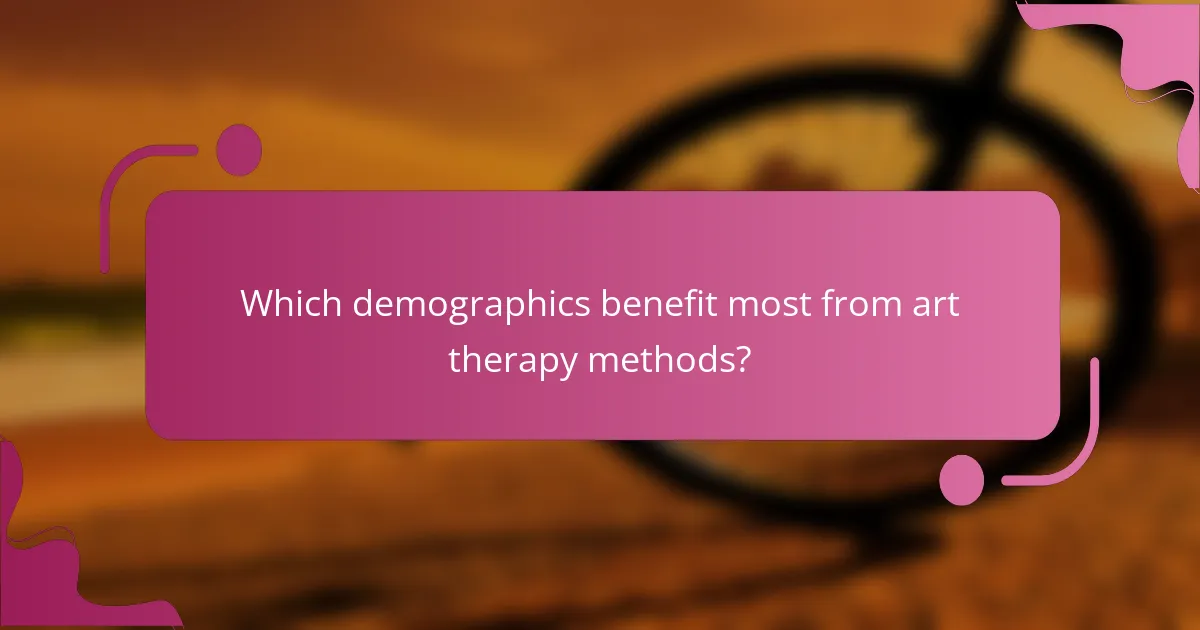
Which demographics benefit most from art therapy methods?
Individuals experiencing trauma, children with emotional challenges, and elderly people with cognitive decline benefit most from art therapy methods. Art therapy enhances creativity and self-expression, fostering mental wellness across diverse demographics.
Trauma survivors often find relief through creative outlets, allowing them to process difficult emotions. Children can express feelings they may not articulate verbally, promoting emotional development. Elderly individuals engage in art therapy to stimulate cognitive function and improve overall well-being.
Research indicates that art therapy can lead to significant reductions in anxiety and depression across these groups. For instance, a study found that 75% of participants reported improved emotional states after engaging in art therapy sessions.
Art therapy’s adaptability makes it a valuable tool for various demographics, addressing unique needs while enhancing mental health.
How does age influence the effectiveness of art therapy?
Age significantly influences the effectiveness of art therapy, as different age groups respond uniquely to creative expression. Younger individuals often engage more freely in imaginative processes, while older adults may benefit from art therapy’s reflective nature.
Research indicates that children use art to communicate emotions, enhancing cognitive and emotional development. In contrast, seniors may find solace in reminiscing through art, improving mental wellness and reducing feelings of isolation.
As a result, tailoring art therapy techniques to specific age demographics can maximize therapeutic outcomes. For instance, interactive and playful methods may resonate more with children, whereas structured sessions focusing on life experiences might appeal to older adults.
Understanding these age-related differences allows therapists to implement strategies that align with the developmental stages and emotional needs of their clients, ultimately enhancing the therapeutic experience.
What unique challenges do different cultural groups face in accessing art therapy?
Different cultural groups face unique challenges in accessing art therapy due to language barriers, cultural stigma, and financial constraints. Language differences can hinder effective communication with therapists. Cultural stigma around mental health may prevent individuals from seeking help. Additionally, limited financial resources can restrict access to therapy services. These factors collectively impact the effectiveness of art therapy in promoting creativity and mental wellness across diverse populations.
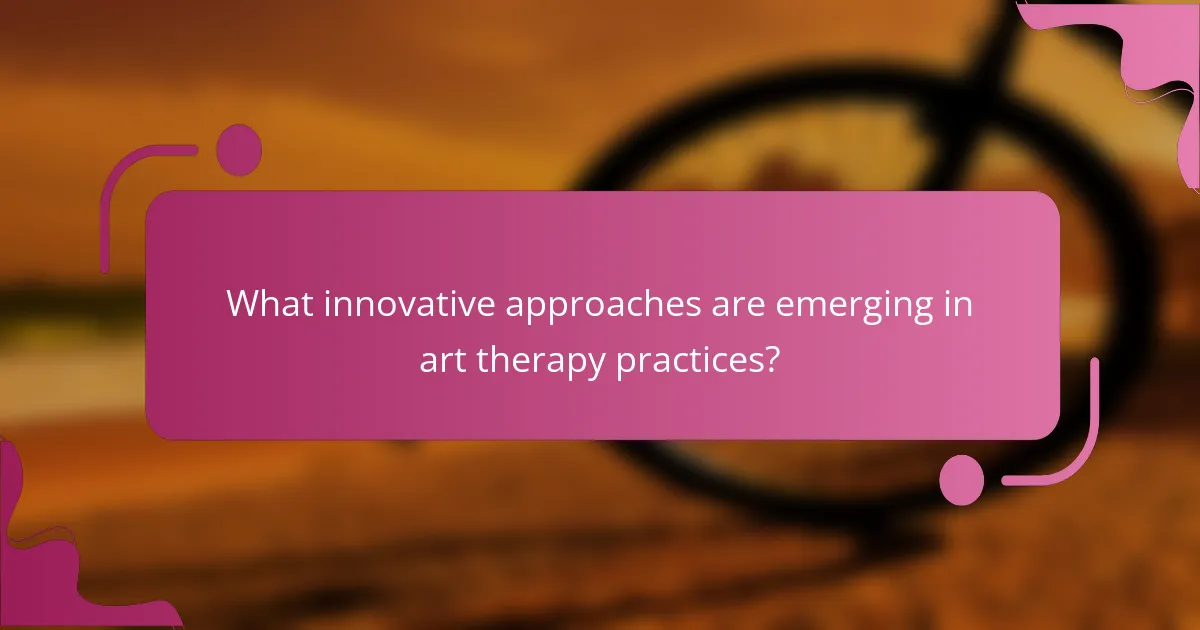
What innovative approaches are emerging in art therapy practices?
Innovative approaches in art therapy emphasize experiential techniques, digital tools, and community engagement. These methods enhance creativity, promote self-expression, and support mental wellness.
One emerging technique is the use of virtual reality, allowing clients to immerse themselves in creative environments. This can facilitate emotional exploration and provide a safe space for expression. Additionally, art therapy is increasingly incorporating digital platforms, enabling remote sessions that expand accessibility.
Another trend is the integration of mindfulness practices within art therapy. This combination encourages clients to focus on the present moment, enhancing emotional regulation and self-awareness. Furthermore, community-based art projects foster social connections, helping individuals feel less isolated while promoting collective healing.
These innovative approaches reflect a growing understanding of the diverse needs of individuals seeking therapeutic support through art.
How is technology transforming art therapy methods?
Technology is enhancing art therapy methods by integrating digital tools and platforms. Virtual reality (VR) immerses individuals in therapeutic environments, promoting relaxation and creativity. Mobile applications facilitate self-expression through guided art activities, allowing users to engage at their own pace. Online communities provide support and feedback, fostering connection among participants. Advanced analytics help therapists track progress and tailor interventions effectively, enhancing mental wellness outcomes.
What are the unique attributes of art therapy in community settings?
Art therapy in community settings offers unique attributes that enhance creativity, self-expression, and mental wellness. These attributes include accessibility, group dynamics, cultural relevance, therapeutic engagement, and the promotion of social connections.
Accessibility allows diverse populations to participate, fostering inclusivity. Group dynamics encourage collaboration and shared experiences, enhancing the therapeutic process. Cultural relevance ensures that art therapy resonates with community values and practices. Therapeutic engagement through hands-on activities promotes active participation. Finally, the promotion of social connections helps build support networks among participants, contributing to overall mental wellness.
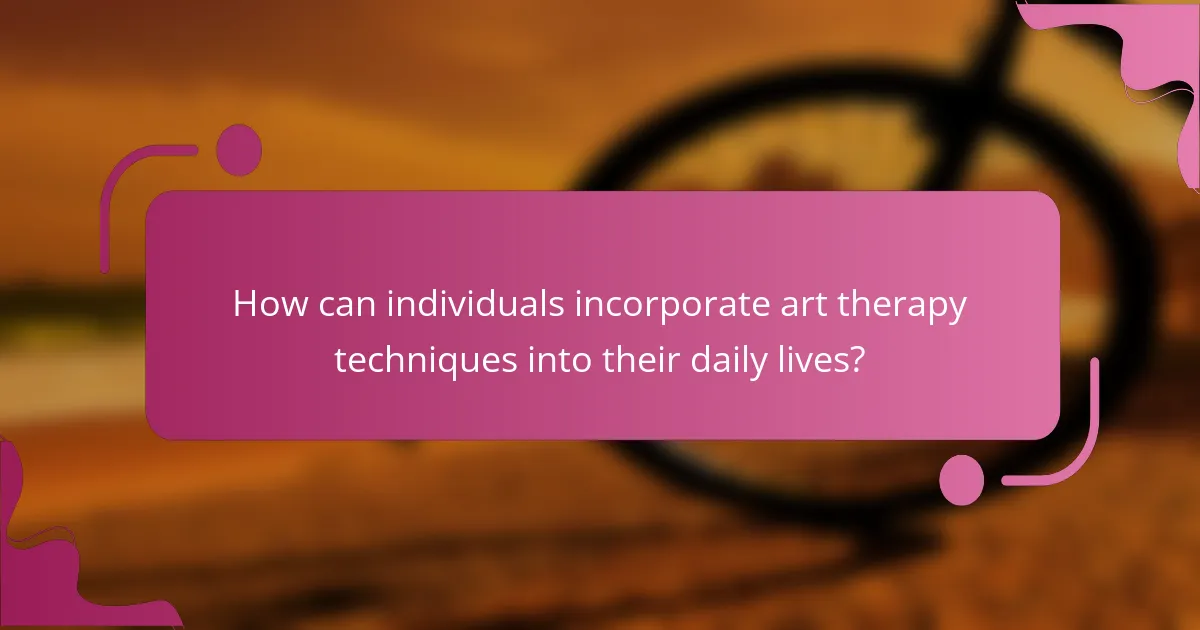
How can individuals incorporate art therapy techniques into their daily lives?
Individuals can incorporate art therapy techniques into their daily lives by engaging in creative activities that promote self-expression and mental wellness. Simple methods include doodling, journaling, and painting. These activities can reduce stress and enhance emotional clarity. Setting aside time for creative expression fosters mindfulness and self-discovery. Joining art groups or workshops can provide social support and inspiration, further enhancing the benefits of art therapy.
What simple art exercises can enhance personal well-being?
Art exercises can significantly enhance personal well-being through creative expression and stress relief. Engaging in simple activities like drawing, painting, or collage-making promotes mindfulness and emotional exploration. These methods encourage self-reflection and can lead to improved mental wellness.
For example, expressive drawing allows individuals to convey feelings visually, while guided imagery in painting fosters relaxation. Additionally, journaling through art can help process emotions and experiences. These exercises are accessible and can be tailored to individual preferences, making them effective tools for enhancing overall well-being.
Which resources are recommended for beginners in art therapy?
Recommended resources for beginners in art therapy include books, online courses, and workshops. “The Art Therapy Sourcebook” by Cathy Malchiodi offers foundational knowledge. Online platforms like Coursera provide courses on art therapy techniques. Local community centers often host workshops that emphasize hands-on experience. Additionally, joining art therapy associations can connect beginners with mentors and resources.
What common mistakes should be avoided when practicing art therapy?
Common mistakes to avoid in art therapy include neglecting personal expression, focusing too much on technique, and ignoring emotional responses. Practitioners should prioritize creativity over perfection to facilitate mental wellness. Additionally, failing to create a safe space can hinder self-exploration. Lastly, overlooking the importance of reflection can limit the therapeutic benefits.
